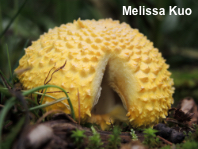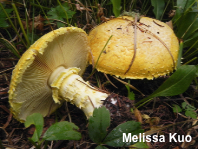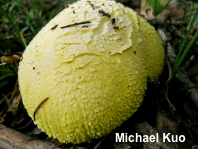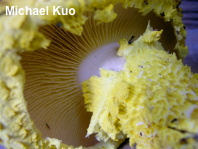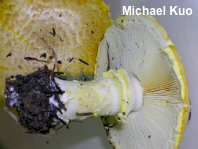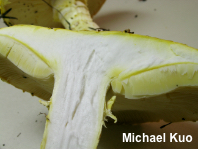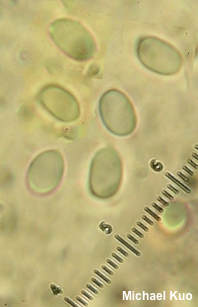| Major Groups > Gilled Mushrooms > Pale-Spored > Tricholoma / Floccularia > Floccularia luteovirens |
| Major Groups > Gilled Mushrooms > Saw-Gilled Mushrooms > Floccularia luteovirens |

|
Floccularia luteovirens [ Basidiomycota > Agaricales > Agaricaceae > Floccularia . . . ] by Michael Kuo In North America Floccularia luteovirens is a western species, fairly commonly encountered in aspen stands and spruce-fir forests, especially in grassy areas. When young and fresh it is a gorgeous bright yellow, and its cap and stem are adorned with large, soft scales. Other defining features include its Tricholoma-like stature, its impressive ring, its attached gills, and its amyloid spores. At the moment the official name for our North American species is "Floccularia straminea var. americana f. americana," but that name represents a form of a variety of a species that no longer exists, since Floccularia straminea has long been reduced to synonymy with Floccularia luteovirens. And the logic for separating our North American version from Europe's Floccularia luteovirens (Mitchel & Smith 1976) was based entirely on subtle morphological differences that are easily accounted for by the present-day European concept of Floccularia luteovirens (see Lange 2018 or Læssøe & Petersen 2019). Therefore, in the absence of contemporary, DNA-based evidence, Floccularia luteovirens is the best choice of names for our continent's mushroom. Description: Ecology: Mycorrhizal; growing terrestrially in grassy areas under aspens or conifers; growing alone, scattered, or gregariously; late summer and fall; Rocky Mountains; also distributed in Europe and Asia. The illustrated and described collections are from Colorado. Cap: 5–13 cm; convex when young, becoming planoconvex to nearly flat; dry; covered with bright yellow, appressed fibrillose scales over a whitish ground that is often not visible until old age (the mushroom's old age, not yours); the margin adorned with shaggy partial veil remnants. Gills: Attached to the stem, usually by a notch; close or crowded; short-gills frequent; pale yellow; edges often jagged. Stem: 5–12 cm long; 1.5–3.5 cm thick; equal, or enlarging toward the base; white and bald near the apex; sheathed below with shaggy yellow scales over a whitish ground; with a shaggy, yellow, double ring; basal mycelium white and prominent. Flesh: White; not changing on exposure; firm when young and fresh. Odor and Taste: Not distinctive. Chemical Reactions: KOH on cap surface negative or erasing yellow. Dried Specimens: Cap and stem lose all yellow shades and become dull whitish; gills become dirty brownish. Spore Print: White. Microscopic Features: Spores 6–7 x 3.5–4.5 µm; ellipsoid; smooth; weakly to moderately amyloid. Lamellar trama parallel. Basidia 4-sterigmate. Hymenial cystidia not found. Pileipellis a cutis or collapsing trichoderm; elements 4–10 µm wide, smooth, thin-walled, hyaline in KOH; clamp connections present; terminal cells with rounded apices. REFERENCES: (Albertini & Schweinitz, 1805) Pouzar, 1957. (Smith, 1975; Mitchel & Smith, 1976; Smith, Smith & Weber, 1979; States, 1990; Phillips, 1991/2005; Lincoff, 1992; Kuo & Methven, 2010; Evenson, 2015; Cripps, Evenson & Kuo, 2016; Lange, 2018; Læssøe & Petersen, 2019.) Herb. Kuo 08060509, 08150701, 08201201, 08141510. This site contains no information about the edibility or toxicity of mushrooms. |
© MushroomExpert.Com |
|
Cite this page as: Kuo, M. (2020, February). Floccularia luteovirens. Retrieved from the MushroomExpert.Com Web site: http://www.mushroomexpert.com/floccularia_luteovirens.html |
